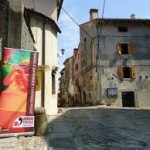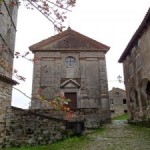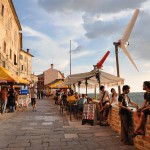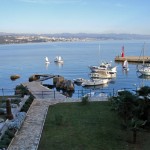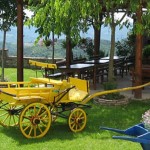While most tourists tend to gravitate towards the coastline, let’s not forget that about a third of Istria is forested and carpeted with vineyards, olive trees, pastures, orchards and rolling hilltops that offer amazing views.
You might want to visit towns and villages such as Grožnjan which looks over the Mirna River Valley and, like its neighbouring Istrian villages, sits atop a hill.
Grožnjan was abandoned for many years until it was re-inhabited in the 1960s by a group of artisans and since then, many painters, sculptors and musicians from around the world have come here to live and work.
Today Grožnjan has over 30 different galleries and art studios and is a renowned meeting point for international artists. It’s also a centre for young people from all over the world who come here for a summer music school and attend classes for various instruments.
In the summer, all of Grožnjan becomes a stage on which distinguished jazz and classical musicians alternate, as do many other artists who have discovered the true joy of creation here. Over 20,000 people from around the globe visit during the acclaimed annual International Cultural Centre of Jeunesses Musicales Croatia which runs from May until September.
- Annual International Vocal Arts Workshop and Performance Progamme
- Grožnjan Art Galleries
- Groznjan Festival
Hum, with a population variously quoted at between 18 and 30, is a tiny medieval travel wonder on the Istrian peninsula, officially listed by the Guinness Book of Records as the smallest town in the world. Such recognition swells this village, of little more than two streets and a dozen grey stone houses, with hundreds of visitors in the summer months.
There’s a small tavern at the top of the ‘hill’ where you can catch your breath, sip the local grappa istra bisque and look out over the striking scenery.
- Church of St. Jerolim (Sv. Jerolim)
- One of two small streets
- Kotli, Hum
Kvarner, one of Croatia’s top secrets, has several popular resorts from the celebrated tourist centre of Opatija to Kraljevica and Crikvenica. The area is frequented by tourists in winter as well, due to its mild climate and easy accessibility. The carnival season from January until March is particularly interesting and tourists who want to experience nature must visit the islands with their well-preserved flora and fauna.
Opatija was once upon a time the grand dame of Croatian tourism. It was the most fashionable seaside resort during the Austro-Hungarian Empire and many fine hotels, residences and houses were built there during that period. European royalty were known to have stayed there then, as did many famous celebrities.
Opatija is now one of the most favoured resorts on the Adriatic, known for its well-tended parks, small botanical gardens, cosy restaurants and elegant turn of the century as well as modern hotels.
Motovun, known to be one of the most visited tourist centres in Istria, is a city with over one thousand steps that lead to old and preserved streets, squares and houses. At the top, you’ll find beautiful views over the vineyards and forests that will take your breath away.
More than 20,000 people from around the world visit the renowned annual Motovun Film Festival during the summer months. Even in winter, this city doesn’t sleep – in October the city gates open in celebration of the Days of Truffles, for fans of these expensive aphrodisiac mushrooms.
- Motovun Film Festival
- Motovun Cafes
- Motovun vineyard
 Plitvice Lakes National Park, Croatia’s most popular tourist attraction, was granted UNESCO World Heritage status in 1979 and a visit to the lakes is a must during your stay. If you are undecided as to whether or not you should visit, take a look at any photo album of the park and you will surely be convinced.
Plitvice Lakes National Park, Croatia’s most popular tourist attraction, was granted UNESCO World Heritage status in 1979 and a visit to the lakes is a must during your stay. If you are undecided as to whether or not you should visit, take a look at any photo album of the park and you will surely be convinced.
With its green forest and tumbling waterfalls, the idyllic Plitvice Lakes National Park can lay claim to some of the most beautiful waterfalls in the world. Visitors and, indeed, the media have described the stunning park as ‘an Eden’ and ‘Mother Nature in her loveliest, most scenic guise’ .
The beauty of the national park lies in its sixteen lakes, inter-connected by a series of waterfalls and set in deep woodland populated by deer, bears, wolves, boars and rare birds. Walk or take the panoramic train through the park or hop on the electric boat, which takes you from one side of the largest lake to the other, and enjoy the stunning scenery.
Sovinjak, a small Istrian medieval town with its Parish Church of St George (circa 1557), sits high upon a hilltop. Many people call this region holy country because of its clean and fresh air, peace and quiet, vineyards and olive groves, truffles and kind people.
Here, you can take in the scenery and enjoy the home grown cuisine, the homemade wines and grappa at Santa-Terra, a wonderful Konoba with a beautiful view of the surrounding area. This estate offers homemade Istrian dishes – maneštra and fuži (types of pasta), gnocchi, sausages, ombolo and pršut (types of cured meat), cheeses, wild asparagus and truffles.
- Opatija / Opatija harbour
- Plitvička jezera / Plitvice lakes
- Plitvička jezera / Plitvice lakes
- Plitvice Lakes
- Plitvice Lakes
- Sovinjak





